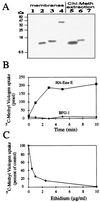EmrE, a small Escherichia coli multidrug transporter, protects Saccharomyces cerevisiae from toxins by sequestration in the vacuole
- PMID: 9922260
- PMCID: PMC93463
- DOI: 10.1128/JB.181.3.949-956.1999
EmrE, a small Escherichia coli multidrug transporter, protects Saccharomyces cerevisiae from toxins by sequestration in the vacuole
Abstract
In this report we describe the functional expression of EmrE, a 110-amino-acid multidrug transporter from Escherichia coli, in the yeast Saccharomyces cerevisiae. To allow for phenotypic complementation, a mutant strain sensitive to a series of cationic lipophilic drugs was first identified. A hemagglutinin epitope-tagged version of EmrE (HA-EmrE) conferring resistance to a wide variety of drugs, including acriflavine, ethidium, methyl viologen, and the neurotoxin 1-methyl-4-phenylpyridinium (MPP+), was functionally expressed in this strain. HA-EmrE is expressed in yeast at relatively high levels (0.5 mg/liter), is soluble in a mixture of organic solvents, and can be functionally reconstituted in proteoliposomes. In bacterial cells, EmrE removes toxic compounds by active transport through the plasma membrane, lowering their cytosolic concentration. However, yeast cells expressing HA-EmrE take up 14C-methyl viologen as well as control cells do. Thus, we investigated the basis of the enhanced resistance to the above compounds. Using Cu2+ ions or methylamine, we could selectively permeabilize the plasma membrane or deplete the proton electrochemical gradients across the vacuolar membrane, respectively. Incubation of yeast cells with copper ions caused an increase in 14C-methyl viologen uptake. In contrast, treatment with methylamine markedly diminished the extent of uptake. Conversely, the effect of Cu2+ and methylamine on a plasma membrane uptake system, proline, was essentially the opposite: while inhibited by the addition of Cu2+, it remained unaffected when cells were treated with methylamine. To examine the intracellular distribution of HA-EmrE, a functional chimera between HA-EmrE and the green fluorescent protein (HA-EmrE-GFP) was prepared. The pattern of HA-EmrE-GFP fluorescence distribution was virtually identical to that of the vacuolar marker FM 4-64, indicating that the transporter is found mainly in this organelle. Therefore, HA-EmrE protects yeast cells by lowering the cytoplasmic concentrations through removal of the toxin to the vacuole. This novel way of detoxification has been previously suggested to function in organisms in which a large vacuolar compartment exists. This report represents the first molecular description of such a mechanism.
Figures




Similar articles
-
EmrE, a multidrug transporter from Escherichia coli, transports monovalent and divalent substrates with the same stoichiometry.J Biol Chem. 2004 Nov 19;279(47):48787-93. doi: 10.1074/jbc.M408187200. Epub 2004 Sep 15. J Biol Chem. 2004. PMID: 15371426
-
Scanning cysteine accessibility of EmrE, an H+-coupled multidrug transporter from Escherichia coli, reveals a hydrophobic pathway for solutes.J Biol Chem. 1999 Jul 2;274(27):19480-6. doi: 10.1074/jbc.274.27.19480. J Biol Chem. 1999. PMID: 10383465
-
Precious things come in little packages.J Mol Microbiol Biotechnol. 2001 Apr;3(2):155-62. J Mol Microbiol Biotechnol. 2001. PMID: 11321568 Review.
-
EmrE, an Escherichia coli 12-kDa multidrug transporter, exchanges toxic cations and H+ and is soluble in organic solvents.J Biol Chem. 1995 Mar 24;270(12):6856-63. doi: 10.1074/jbc.270.12.6856. J Biol Chem. 1995. PMID: 7896833
-
EmrE, the smallest ion-coupled transporter, provides a unique paradigm for structure-function studies.J Exp Biol. 1997 Jan;200(Pt 2):335-41. doi: 10.1242/jeb.200.2.335. J Exp Biol. 1997. PMID: 9050242 Review.
Cited by
-
The similar and different evolutionary trends of MATE family occurred between rice and Arabidopsis thaliana.BMC Plant Biol. 2016 Sep 26;16(1):207. doi: 10.1186/s12870-016-0895-0. BMC Plant Biol. 2016. PMID: 27669820 Free PMC article.
-
Evidence that fungal MEP proteins mediate diffusion of the uncharged species NH(3) across the cytoplasmic membrane.Mol Cell Biol. 2001 Sep;21(17):5733-41. doi: 10.1128/MCB.21.17.5733-5741.2001. Mol Cell Biol. 2001. PMID: 11486013 Free PMC article.
-
Functional Role of YnfA, an Efflux Transporter in Resistance to Antimicrobial Agents in Shigella flexneri.Antimicrob Agents Chemother. 2022 Jul 19;66(7):e0029322. doi: 10.1128/aac.00293-22. Epub 2022 Jun 21. Antimicrob Agents Chemother. 2022. PMID: 35727058 Free PMC article.
-
Directed evolution reveals hidden properties of VMAT, a neurotransmitter transporter.J Biol Chem. 2010 Feb 12;285(7):5076-84. doi: 10.1074/jbc.M109.081216. Epub 2009 Dec 10. J Biol Chem. 2010. PMID: 20007701 Free PMC article.
-
A two-component multidrug efflux pump, EbrAB, in Bacillus subtilis.J Bacteriol. 2000 Apr;182(8):2307-10. doi: 10.1128/JB.182.8.2307-2310.2000. J Bacteriol. 2000. PMID: 10735876 Free PMC article.
References
-
- Arkin I, Russ W, Lebendiker M, Schuldiner S. Determining the secondary structure and orientation of EmrE, a multi-drug transporter, indicates a transmembrane four helix bundle. Biochemistry. 1996;35:7233–7238. - PubMed
-
- Benderra Z, Morjani H, Trussardi A, Manfait M. Role of the vacuolar H+-ATPase in daunorubicin distribution in etoposide-resistant MCF7 cells overexpressing the multidrug-resistance associated protein. Int J Oncol. 1998;12:711–715. - PubMed
-
- Bennetzen J L, Hall B D. Codon selection in yeast. J Biol Chem. 1982;257:3026–3031. - PubMed
-
- Bobichon H, Colin M, Depierreux C, Liautaud-Roger F, Jardillier J C. Ultrastructural changes related to multidrug resistance in CEM cells: role of cytoplasmic vesicles in drug exclusion. J Exp Ther Oncol. 1996;1:49–61. - PubMed
Publication types
MeSH terms
Substances
Grants and funding
LinkOut - more resources
Full Text Sources
Other Literature Sources
Medical

